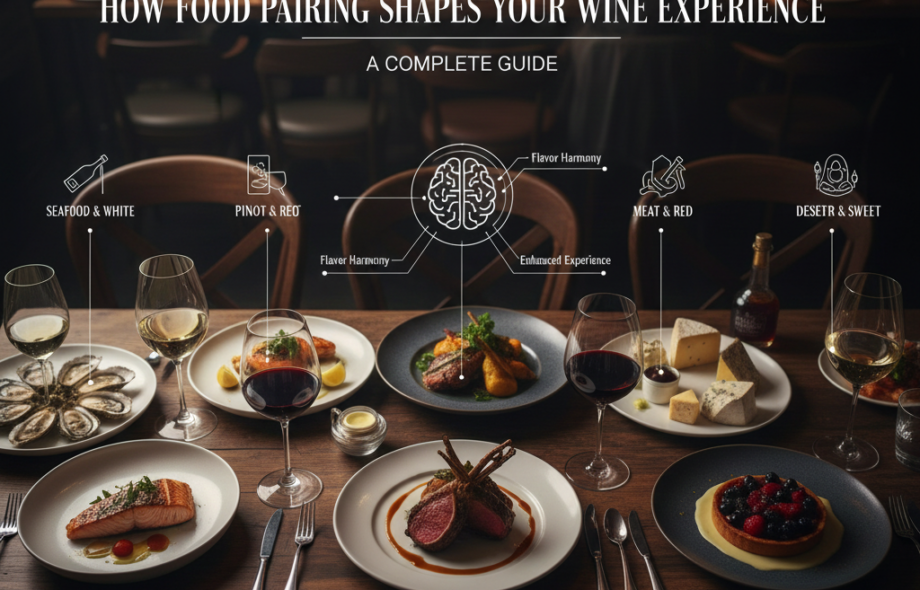Wine tasting is a beautiful experience on its own, but when paired with the right food, it becomes unforgettable. The relationship between wine and food is rooted in science, balance, and sensory harmony. Whether you’re a beginner or a seasoned wine lover, understanding how food pairing works can elevate every sip and bite you enjoy. This guide will help you discover how flavors interact and how to choose the perfect wine for any meal.
Why Food Pairing Matters
Food pairing enhances both the dish and the wine. The right match brings out hidden notes, rounds off sharp edges, and creates a more enjoyable overall experience.
A great pairing can:
• Make wine taste smoother
• Enhance fruit or spice notes
• Highlight texture and aroma
• Create a more balanced, satisfying meal
On the other hand, the wrong pairing can make wine taste bitter, flat, or overly acidic.
1. Balance is the Key Principle
The most important rule of pairing is balance—neither the food nor the wine should overpower the other.
For example:
• Heavy, rich dishes need bold wines with structure.
• Light dishes pair best with lighter, brighter wines.
Think of it as matching intensity with intensity.
2. Acidity: Freshness That Cuts Through Richness
Acidic wines pair beautifully with rich or fatty foods.
Why? Because acidity cuts through fat and cleanses the palate.
Great combinations:
• Sauvignon Blanc with goat cheese
• Champagne with fried foods
• Riesling with spicy Asian dishes
High-acid wines bring balance and freshness to rich meals.
3. Sweetness: Taming Heat & Spice
Sweetness in wine helps soften spicy or salty flavors.
Try these:
• Off-dry Riesling with Indian or Thai cuisine
• Moscato with spicy barbecue
• Sweet wines with salty cheeses
This balance prevents heat from overwhelming the palate.
4. Tannins: Perfect for Protein
Tannins in red wine bind with proteins in food, making wine feel smoother.
Classic matches:
• Cabernet Sauvignon with steak
• Malbec with grilled meats
• Syrah/Shiraz with hearty beef or lamb dishes
The protein softens the tannins, creating a harmonious experience.
5. Body Matching: Light vs. Heavy
Pair wine and food with similar weight.
Light wines:
• Pinot Grigio
• Albariño
• Beaujolais
Pair with salads, seafood, and light pasta.
Full-bodied wines:
• Chardonnay (oaked)
• Cabernet Sauvignon
• Zinfandel
Pair with creamy dishes, red meats, and rich sauces.
6. Complement or Contrast: Two Winning Strategies
There are two successful pairing approaches:
Complementing
Enhancing similar flavors—like buttery Chardonnay with buttery lobster.
Contrasting
Balancing opposite flavors—like salty blue cheese with sweet dessert wine.
Both methods create harmony, just in different ways.
7. Regional Pairing: What Grows Together, Goes Together
Traditional wine regions perfected pairings over centuries.
Examples:
• Italian Chianti with tomato-based pasta
• French Sancerre with goat cheese
• Spanish Albariño with seafood
Local wines and local dishes are timeless partners.
Putting It All Together
To pair like a pro, simply remember:
1. Match intensity
2. Use acidity to refresh
3. Tame spice with sweetness
4. Use tannins with protein
5. Match body
6. Complement or contrast
7. Trust regional wisdom
With these simple rules, you can turn any meal into a gourmet experience.
Download Vinora — Your Smart Food & Wine Pairing Guide
📱 iOS:
https://apps.apple.com/in/app/vinora/id6744821564
📱 Android:
https://play.google.com/store/apps/details?id=com.vinora&hl=en_US
Follow Us for Updates
📸 Instagram:
https://www.instagram.com/vinora_official/
 :
https://in.pinterest.com/vinora_official/
:
https://in.pinterest.com/vinora_official/


